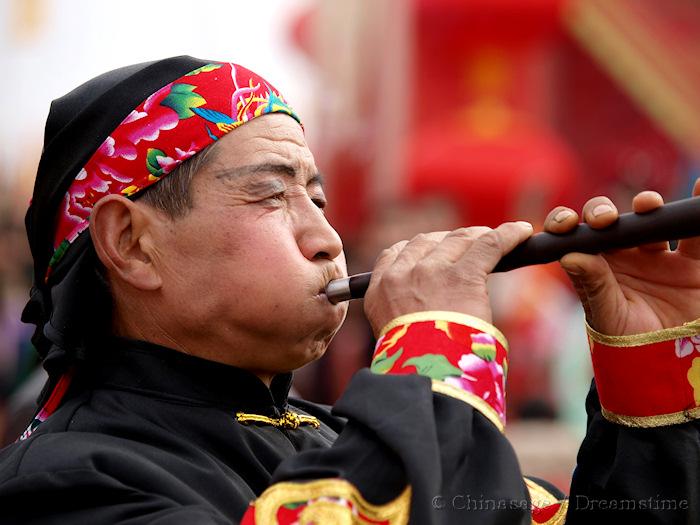Chinese Music 音乐 yīn yuè
China has a strong historical tradition in music even though she has now embraced the modern ‘western’ style of music too. These days you can hear a very diverse range of music in China. The character for ‘music’ 乐 yuè is written the same as lè ‘happy’, surely demonstrating a harmonious connection.
Traditionally the Chinese musical instruments are placed into categories based on the material they are made from:
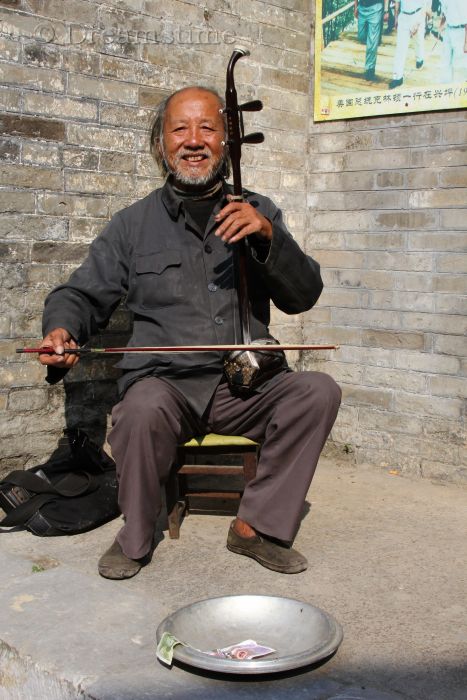
Stone
Includes the Bianqing which is a set of ‘L’ shaped stones suspended from a stand like bells and hit with a hammer. They are traditionally made from jade. They date back as far as 1500BCE (Shang dynasty). The musical stone (磬 qìng) is used in a painting to represent steadfastness.
Metal
Bells; gongs (luo) and cymbals (bo) are often used in Beijing Opera music
Silk/Strands
All the stringed instruments are in this category. Stringed instruments represent faithfulness and in particular, the lute represents the moon and marital harmony. There are many types in two main groups: bowed string: Erhu (the two stringed violin); Sihu (four stringed); Jinghu (used in traditional opera orchestras); Gaohu; Gehu; Banhu; Matouqin and plucked strings: Guzheng; Pipa; Liuqin; Yangqin; Ruan; Yueqin; Guqin (seven stringed); Sanxian (three stringed); Zheng (thirteen string zither). Of these the guqin is perhaps the best known, it is four feet long and played on a table traditionally using seven silk strings.
Bamboo
Wind instruments were traditionally made from bamboo. They include: . Dizi (flute, side blown); Xiao (flute, end blown, five holes in upper section one in lower); Xun; Sheng (mouth organ with 13 or 17 small pipes).
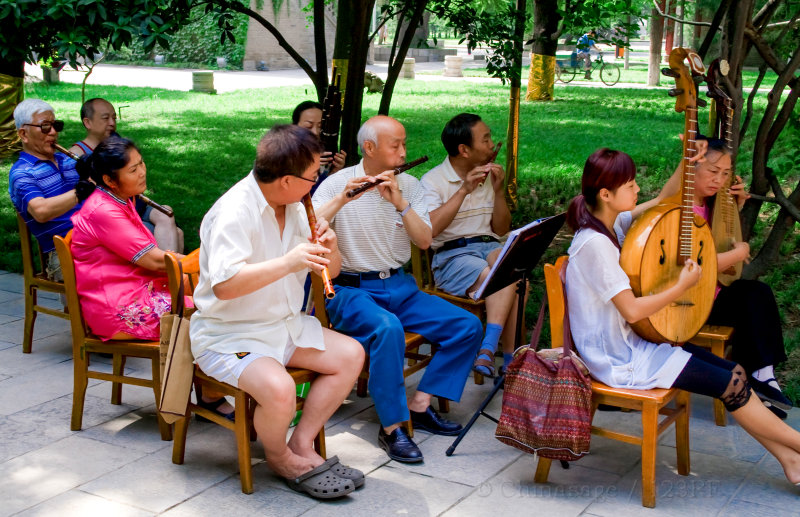
Wood
The Suona a type of trumpet is usually made from wood. The Guan has a double reed and has 8 or 9 holes. Percussion instruments are often made from wood. They play an important part in the accompaniment of Chinese Opera – including wooden blocks, clappers, and wooden xylophones.
Skin
Skin is traditionally used to cover drums. The ancient forms were made of earthenware with animal skin; there is also a narrow, long drum made of a bamboo tube with a snakeskin sounding surface sometimes called a fish drum. Great drums (gu) have been used for signaling and time keeping for thousands of years.
Drums have played a very important in ceremonial occasions for centuries. They were used to announce the start of a battle and are still used at all kinds of festive occasions. The city of Xi'an has a famous Drum tower at the center of the city. It marked the pulse of daily life as the great drum housed in the town's central Drum Tower announced the start and end of the day.
Gourd
The Sheng (mouth organ) has a body made out of a gourd with bamboo pipes affixed to provide different notes. Some have as many as seventeen bamboo tubes inserted into a gourd. Legend says it was invented by the goddess Nüwa and it symbolizes the phoenix and was played at many formal occasions. The sounds are produced just as much while sucking in air as blowing.
Clay
The Ocarina dates back to the Shang dynasty and is a small egg shaped instrument with six holes.
Chinese music videos
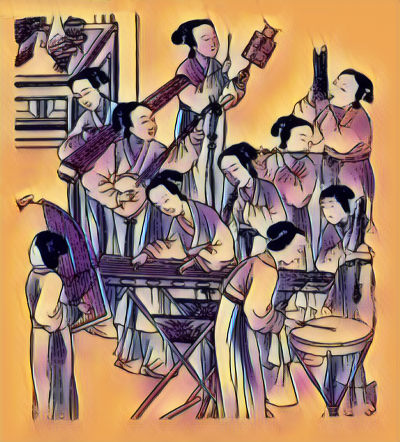
To appreciate Chinese music it is best to hear and see it being played, so here are a number of videos of musical performances of solo instruments and ensembles.
Playing the Erhu: River of Sorrow 江河水
The Erhu 二胡 èr hú is the most common Chinese string instrument. It is rather like a tiny violin but with only two strings and the bow threaded between the strings. It can play 3½ octaves and is played by resting on the left thigh (if right handed). The strings are made of silk (or steel) and are tuned to the notes 'A' and 'D'. It has a mellow, wistful sound.
Playing the Pipa: Ambushed from All sides 十面埋伏 Shí miàn mái fú
The Pipa came to China from Central Asia at about the time of the Han dynasty.
Playing the Chinese flute (Dizi)
Playing the Chinese zither (Guqin): Lament on Departure 长亭怨慢 Cháng tíng yuàn màn
Although not as widely played as the Erhu the Guqin 古琴 gǔ qín has a longer tradition. The instrument is placed on a table and played by plucking the strings with the right-hand while the left-hand modifies the note played. Over twenty note making techniques are studied by students.
Playing the Chinese hammered dulcimer (Yangqin 扬琴): Spring on the River Qing 春到清江 Chūn dào qīng jiāng
Playing the Chinese mouth organ (Sheng)
Playing Chinese bells (Bianzhong)
Traditional Ensemble piece: Blossoms on a Moonlit River in Spring 春江花月夜
A range of Traditional Chinese instruments played together
Music is documented as far back as the Zhou dynasty and forms an important thread in the Confucian tradition. Musical harmony was believed to bring harmony to life. Confucius said he could predict a kingdom's problems from hearing the music played at court. He disapproved of 'immoral' dance music and thought that the noisier the music was, the more likely that the state was in jeopardy. Music was more than mere background entertainment it set the whole mood and character of thought. Chinese music was an harmonious emanation tied up with the concept of ‘qi’ the all pervading life-essence. In the tomb of the Marquis Yi of Zeng ➚ dating to about 430BCE 124 musical instruments of all types and sizes were found.
Chinese bells have survived from the days of the early dynasties, arranged in a series of twelve notes 十二律 shí èr lù:, the bells were struck with a rod. By tradition this scale was devised by the Yellow Emperor himself. The notes do not form a scale - a scale is built by choosing notes from the range of bells. The tuning of notes followed a different approach to the Western octave. The octave attempts to divide a doubling of frequency evenly with notes. The old Chinese method did not use an octave instead notes were progressively tuned relative to the other ones. Notes were tuned to a frequency 2/3 and 3/4 of the current note, so the whole sequence of notes were in harmonious relation to each other. This method avoids the problems of tuning in octaves known as temperament ➚. Zhu Zaiyu ➚ discovered equal temperament in 1584 long before that in Europe but it was not taken up widely in China. The Legendary Yellow Bell ➚ 黄钟 huáng zhōng is associated with the Yellow Emperor whose minister developed the perfect flute nine Chinese inches long.
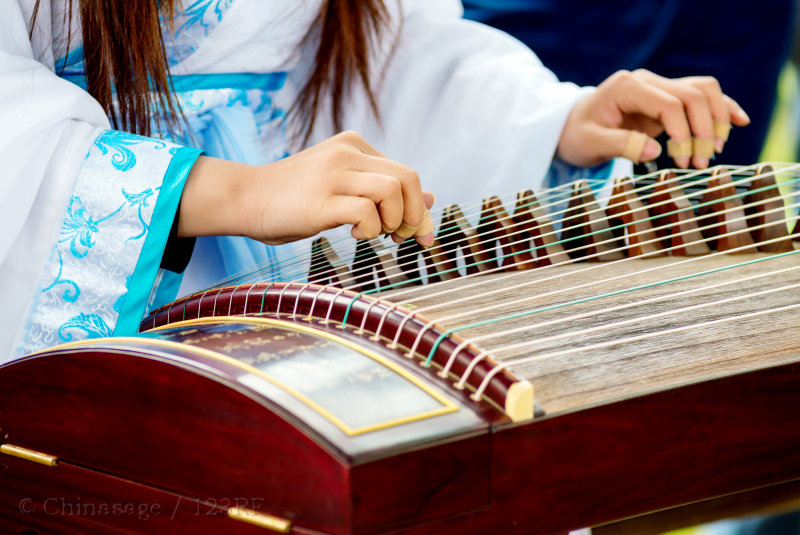
After the Zhou dynasty the five note (pentatonic) scale was adopted. It consists of five tones associated with the five elements and is mentioned in the dynastic records. The five notes are C; D; E; G and A in western notation. Each dynasty was associated with one of the five elements so the court music changed to use the appropriate key note on change od dynasty. Five different musical modes were used with notes in different orders: gong, shang, jiao, zhi and yu. The combination of the twelve notes series with the five modes gives sixty distinct tones. There was also a seven note scale with the notes of C; D; E; F; G; A and B.
By the Han dynasty the imperial court had employed scholars to collect and record tunes and folk songs from all over China. Central Asian music came into China during the Sui dynasty and became widely popular in the following Tang dynasty; it displaced traditional Chinese music for a while. During the Tang, groups of musicians began to perform as an orchestra and the Gongche ➚ Chinese musical notation was devised to write down the score . This very early written notation was a list of the twelve basic tones but without indication of the note's duration. Music for the guqin is known from 3,000 ancient scores and these are probably the world's oldest recorded instrumental music. A scholar-official was expected to be proficient with a musical instrument, in particular the guqin. Scholars would meet in the evening and spend the time reciting poems; playing music, writing calligraphy and painting. The splendor of Tang music was exported to Japan, and the tradition has survived virtually unchanged there.
In Suzhou there is a strong tradition of 弹词 Tán cí where a story-teller accompanies him or herself with a musical instrument (typically a pipa or sanxian).
Traditional Chinese music came back into popularity during the Cultural Revolution when ‘Western music’ particularly orchestral music was denigrated and forbidden. The step had a large touch of hypocrisy because at the same time many other ancient Chinese customs and traditions were suppressed. However since Deng Xiaoping's reforms in the 1980s, music from all corners of the world has been accepted and welcomed in China.
